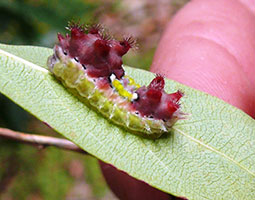Doratifera vulnerans
Description

Adults have a dark brown abdomen and mottled brown wings. Each forewing has a pale grey terminal area and an indistinct pale discal spot. The hindwings are uniformly light brown. The moths have a wingspan of about four cms. Adults characteristically sit on a twig with the body nearly perpendicular to the twig. Sometimes they sit with their wings folded so that the tips overhang the twig.
Adult cup moths lay clusters of forty or so eggs on the leaves of food plants such as Eucalyptus, and often cover them with hairs from their own bodies.
When the caterpillars hatch, they begin to feed in groups on the surface of a leaf. As they mature, they move off to feed on a whole leaf each. The 2 cm long caterpillars have four knobs at each end with expandable crowns of stinging spines. The caterpillars are grey-green to red with a 'skirt' of green spikes along the sides of their bodies and a yellow and green 'saddle' on the middle.
Adaptations
The larvae can deliver a painful sting and are among the few venomous caterpillars. They usually have many short spines, either scattered over the body, or in dense, expandable clusters on tubercles. Each spine is hollow and filled with venom produced by a gland at the base. On contact with skin the tip of the spines break as they penetrate the skin, injecting the venom.
Feeding relationships
- What I eat: Eucalyptus leaves
- What eats me: Insectivorous birds
Interesting facts
Named for the hard, smooth oval or pear-shaped cocoon (the 'cup') attached by the base to a twig of a eucalypt. The moth emerges by pushing off a circular cap or lid. The now empty cocoon closely resembles a eucalypt 'gumnut'.
Cup moths are susceptible to viruses, are predated on by birds and have a number of natural enemies that include parasitic wasps, flies and biting midges.
Acknowledgements
Coffs Harbour butterfly house
Brisbane Insects
Queensland Museum
Australian Museum
Gardening know how